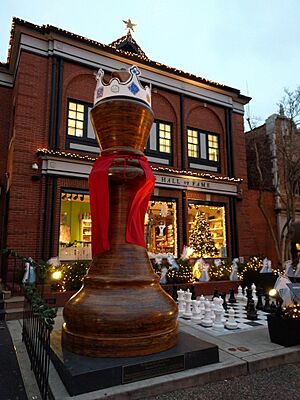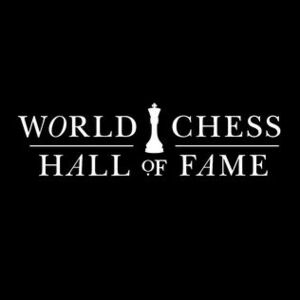World Chess Hall of Fame facts for kids
 |
|

Street view
|
|
| Lua error in Module:Location_map at line 420: attempt to index field 'wikibase' (a nil value). | |
| Former name | U.S. Chess Hall of Fame World Chess Hall of Fame and Sidney Samole Museum |
|---|---|
| Established | 1984 |
| Location | Central West End, St. Louis Missouri |
| Type | Hall of Fame Art museum |
| Public transit access | |
The World Chess Hall of Fame (WCHOF) is a special museum in St. Louis, Missouri. It's a place where chess history comes alive! The museum collects and shows off amazing chess items. It also teaches people about chess and honors the best chess players.
The Hall of Fame started in 1984. It used to be in different cities like New York and Florida. But since September 9, 2011, it has been in St. Louis. It works closely with the Saint Louis Chess Club, which is right across the street. They often team up for fun chess events and lessons.
At the museum, you can see many cool things. There are old chess sets and items from famous games. You can also learn about the history of chess and how it has changed over time. The museum even has a piece from an ancient Egyptian game called senet. This is one of the oldest board games ever known!
Contents
- History of the Hall of Fame
- Honoring Chess Legends
- Past Exhibitions
- Art and Chess: OUT OF THE BOX
- Historic Chess Sets: Chess Masterpieces
- Marcel Dzama: The End Game
- Bobby Fischer: Icon Among Icons
- St. Louis Artists: Screwed Moves
- Chess in Pop Culture: Everybody's Game
- Presidents and Chess: Power in Check
- Bill Smith: Beyond the Humanities
- Antique Chess Sets: Prized and Played
- Fashion and Chess: A Queen Within
- Jacqueline Piatigorsky: Patron, Player, Pioneer
- Music and Art: Cage & Kaino
- Game Design: Strategy by Design
- Bobby Fischer's Career: A Memorable Life
History of the Hall of Fame
The World Chess Hall of Fame began in 1986. It was first called the U.S. Chess Hall of Fame. Steven Doyle, who led the United States Chess Federation at the time, helped start it.
The first museum opened in 1988 in New York. It had a small collection. This included a book signed by the famous chess player Bobby Fischer. It also had a silver set given to Paul Morphy, another great American chess player.
In 1992, the museum moved to Washington, D.C. Here, it focused on America's top four chess players: Paul Morphy, Bobby Fischer, Frank Marshall, and Samuel Reshevsky. The museum also showed the trophy won by the U.S. team in the 1993 World Chess Championship. Visitors could even play against a chess computer! By 2001, the collection had grown a lot.
Later, a man named Sidney Samole suggested moving the museum to Miami. It would be in a building shaped like a rook chess piece. The museum moved there in 2001 and was renamed the World Chess Hall of Fame and Sidney Samole Museum. It kept collecting many chess sets, books, and other cool items until it closed in 2009.
Soon after, a billionaire named Rex Sinquefield helped move the museum to St. Louis. He also paid to fix up its new building. This new home is right across from the St. Louis Chess Club, which Rex Sinquefield also started.
Honoring Chess Legends
The World Chess Hall of Fame honors amazing chess players and people who have helped the game. There are two main groups of honorees: the U.S. Chess Hall of Fame and the World Chess Hall of Fame.
U.S. Chess Hall of Fame Inductees
The U.S. Chess Hall of Fame has 74 members. A special committee chooses people who have made a big impact on chess in the United States. They send their ideas to the U.S. Chess Trust every year. The trustees then vote on who should be added to the Hall of Fame.
The induction ceremony often happens at a big chess event called the U.S. Open. It can also take place at the World Chess Hall of Fame itself.
| Count | Inductee | Induction year |
|---|---|---|
| 1 | Reuben Fine | 1986 |
| 2 | Robert Fischer | 1986 |
| 3 | Isaac Kashdan | 1986 |
| 4 | George Koltanowski | 1986 |
| 5 | Frank Marshall | 1986 |
| 6 | Paul Morphy | 1986 |
| 7 | Harry Pillsbury | 1986 |
| 8 | Sammy Reshevsky | 1986 |
| 9 | Sam Loyd | 1987 |
| 10 | Wilhelm Steinitz | 1987 |
| 11 | Arpad Elo | 1988 |
| 12 | Hermann Helms | 1988 |
| 13 | Al Horowitz | 1989 |
| 14 | Hans Berliner | 1990 |
| 15 | John W. Collins | 1991 |
| 16 | Arthur Dake | 1991 |
| 17 | Arnold Denker | 1992 |
| 18 | Gisela Gresser | 1992 |
| 19 | George MacKenzie | 1992 |
| 20 | Pal Benko | 1993 |
| 21 | Victor Palciauskas | 1993 |
| 22 | Arthur Bisguier | 1994 |
| 23 | Robert Byrne | 1994 |
| 24 | Larry Evans | 1994 |
| 25 | Ed Edmondson Jr. | 1995 |
| 26 | Fred Reinfeld | 1996 |
| 27 | Kenneth Harkness | 1997 |
| 28 | Milan Vukcevich | 1998 |
| 29 | Benjamin Franklin | 1999 |
| 30 | Edmar Mednis | 2000 |
| 31 | Lubomir Kavalek | 2001 |
| 32 | Lev Alburt | 2003 |
| 33 | Walter Browne | 2003 |
| 34 | Donald Byrne | 2003 |
| 35 | Anatoly Lein | 2004 |
| 36 | Leonid Shamkovich | 2004 |
| 37 | Yasser Seirawan | 2006 |
| 38 | Irving Chernev | 2007 |
| 39 | Jeremy Gaige | 2007 |
| 40 | Joel Benjamin | 2008 |
| 41 | Larry Christiansen | 2008 |
| 42 | Nick de Firmian | 2008 |
| 43 | John Fedorowicz | 2009 |
| 44 | Burt Hochberg | 2009 |
| 45 | Diane Savereide | 2010 |
| 46 | Jackson Showalter | 2010 |
| 47 | Herman Steiner | 2010 |
| 48 | Boris Gulko | 2011 |
| 49 | Andy Soltis | 2011 |
| 50 | Alex Yermolinsky | 2012 |
| 51 | Gregory Kaidanov | 2013 |
| 52 | Mona May Karff | 2013 |
| 53 | Abraham Kupchik | 2014 |
| 54 | Jacqueline Piatigorsky | 2014 |
| 55 | Alexander Shabalov | 2015 |
| 56 | Gata Kamsky | 2016 |
| 57 | Maurice Ashley | 2016 |
| 58 | Edward Lasker | 2017 |
| 59 | Bill Goichberg | 2018 |
| 60 | Alex Onischuk | 2018 |
| 61 | Max Judd | 2019 |
| 62 | Susan Polgar | 2019 |
| 63 | William Lombardy | 2019 |
| 64 | Rex Sinquefield | 2020 |
| 65 | Jeanne Sinquefield | 2020 |
| 66 | James Sherwin | 2021 |
| 67 | Frank Brady | 2021 |
| 68 | Daniel Willard Fiske | 2022 |
| 69 | James Tarjan | 2022 |
| 70 | John Watson | 2022 |
| 71 | Yury Shulman | 2023 |
| 72 | Lisa Lane | 2023 |
| 73 | William Shinkman | 2023 |
| 74 | Charles Henry Stanley | 2024 |
World Chess Hall of Fame Inductees
The World Chess Hall of Fame has 53 members. These inductees are chosen by people from the World Chess Federation (FIDE). The first woman to be inducted into the WCHOF was Vera Menchik in 2011. She was the winner of the first Women's World Chess Championship.
| Count | Inductee | Induction year |
|---|---|---|
| 1 | José Raúl Capablanca | 2001 |
| 2 | Robert Fischer | 2001 |
| 3 | Emanuel Lasker | 2001 |
| 4 | Paul Morphy | 2001 |
| 5 | Wilhelm Steinitz | 2001 |
| 6 | Mikhail Botvinnik | 2003 |
| 7 | Tigran Petrosian | 2003 |
| 8 | Vasily Smyslov | 2003 |
| 9 | Boris Spassky | 2003 |
| 10 | Mikhail Tal | 2003 |
| 11 | Alexander Alekhine | 2004 |
| 12 | Max Euwe | 2004 |
| 13 | Anatoly Karpov | 2004 |
| 14 | Garry Kasparov | 2005 |
| 15 | Siegbert Tarrasch | 2008 |
| 16 | Vera Menchik | 2011 |
| 17 | Elisaveta Bykova | 2013 |
| 18 | Mikhail Chigorin | 2013 |
| 19 | Nona Gaprindashvili | 2013 |
| 20 | Maia Chiburdanidze | 2014 |
| 21 | Paul Keres | 2014 |
| 22 | Olga Rubtsova | 2015 |
| 23 | Lyudmila Rudenko | 2015 |
| 24 | Carl Schlechter | 2015 |
| 25 | David Bronstein | 2016 |
| 26 | Sonja Graf | 2016 |
| 27 | Howard Staunton | 2016 |
| 28 | Johannes Zukertort | 2016 |
| 29 | Paula Kalmar-Wolf | 2017 |
| 30 | Viktor Korchnoi | 2017 |
| 31 | Alla Kushnir | 2017 |
| 32 | Aron Nimzowitsch | 2018 |
| 33 | Richard Réti | 2018 |
| 34 | Kira Zvorykina | 2018 |
| 35 | Akiba Rubinstein | 2019 |
| 36 | Mark Taimanov | 2019 |
| 37 | Xie Jun | 2019 |
| 38 | Miguel Najdorf | 2021 |
| 39 | Judit Polgár | 2021 |
| 40 | Eugene Torre | 2021 |
| 41 | Jorgen Bent Larsen | 2023 |
| 42 | Lajos Portisch | 2023 |
| 43 | Susan Polgár | 2023 |
| 44 | Zhu Chen | 2024 |
| 45 | Irina Levitina | 2024 |
| 46 | Elena Donaldson-Akhmilovskaya | 2024 |
| 47 | Fridrik Olafsson | 2024 |
| 48 | Lev Polugaevsky | 2024 |
| 49 | Nana Alexandria | 2024 |
| 50 | Robert Hübner | 2024 |
| 51 | Vladimir Kramnik | 2024 |
| 52 | Efim Geller | 2024 |
| 53 | Oscar Panno | 2024 |
Past Exhibitions
The World Chess Hall of Fame in St. Louis has hosted many interesting exhibitions. These shows feature historical chess items and art from different artists and collectors.
Art and Chess: OUT OF THE BOX
From September 2011 to February 2012, the museum had an art show called OUT OF THE BOX: Artists Play Chess. It showed how artists use chess in their work. One artist even played a chess piano he built! Nine musicians from the Saint Louis Symphony played music as each chess piece was moved.
Historic Chess Sets: Chess Masterpieces
Another exhibition from September 2011 to February 2012 was Chess Masterpieces: Highlights from the Dr. George and Vivan Dean Collection. This show displayed beautiful chess sets from the 10th to the early 20th century. These sets came from many countries, including China, India, and Russia. Some pieces even belonged to famous people like Catherine the Great and Napoleon.
Marcel Dzama: The End Game
From March to August 2012, the museum showed art by Marcel Dzama. His works included films, drawings, and sculptures. His film featured characters dressed as chess pieces. They danced on a checkered board, acting out chess moves.
Bobby Fischer: Icon Among Icons
From March to October 2012, there was a photo exhibition about Bobby Fischer. It featured pictures by Harry Benson, who was the only photographer allowed to be with Bobby Fischer during the 1972 World Chess Championship. Benson captured many personal moments of Fischer.
St. Louis Artists: Screwed Moves
From September 2012 to February 2013, a group of St. Louis artists called The Screwed Arts Collective created a special wall drawing. It was inspired by chess.
Chess in Pop Culture: Everybody's Game
From October 2012 to April 2013, the exhibition Everybody's Game: Chess in Popular Culture explored how chess appears in everyday life. This included magazine ads, rock music posters, and movies.
Presidents and Chess: Power in Check
Also from October 2012 to April 2013, Power in Check: Chess and the American Presidency showed how chess has been part of American presidents' lives. This went all the way back to George Washington.
Bill Smith: Beyond the Humanities
From March to August 2013, the museum featured the work of Bill Smith. His art explored how rules shape our world. He used videos and art to show how chess, nature, and life all have similar patterns.
Antique Chess Sets: Prized and Played
From May to September 2013, the Prized and Played: Highlights from the Jon Crumiller Collection show displayed over 80 old chess sets and other items.
Fashion and Chess: A Queen Within
From October 2013 to April 2014, the exhibition A Queen Within: Adorned Archetypes, Fashion and Chess explored the idea of a queen in fashion and stories.
Jacqueline Piatigorsky: Patron, Player, Pioneer
From October 2013 to July 2014, a show honored Jacqueline Piatigorsky. She was a top female chess player in the 1950s and 1960s. She also supported the game of chess a lot.
Music and Art: Cage & Kaino
From May to September 2014, the Cage & Kaino: Pieces and Performances exhibition featured live performances. It included works by the 20th-century composer John Cage and artist Glenn Kaino.
Game Design: Strategy by Design
From May to September 2014, the Strategy by Design: Games by Michael Graves exhibition focused on games designed by the Michael Graves Design Group.
Bobby Fischer's Career: A Memorable Life
From July 2014 to June 2015, the museum had an exhibition called A Memorable Life: A Glimpse into the Complex Mind of Bobby Fischer. This show looked at the career of World Champion Bobby Fischer.


